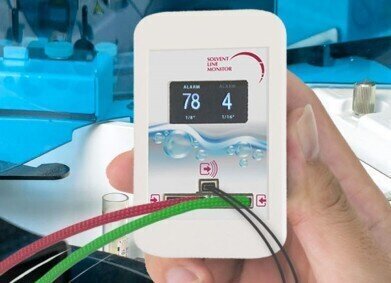-
 Solvent Line Monitor in operation.
Solvent Line Monitor in operation.
Chromatography
Programmable, High Sensitivity Monitor for Detecting Gas Bubbles
Jun 09 2022
Testa Analytical Solutions eKhas launched the Solvent Line Monitor - a programmable, high sensitivity device for detecting gas bubbles in HPLC, Ion chromatography and flow chemistry systems.
Temperature, pressure, reagent concentration, shock or agitation are all common variables that reduce the saturation point of liquids, resulting in the formation of gas bubbles. Most liquid chromatography users will have experienced how gas bubbles can result in changes in retention times, pulsating baselines, unexpected changes in peak areas, irregular peak shapes, pump outages and excessively high back pressures. Similarly, gas bubbles in flow chemistry systems are also a significant problem which can negatively affect correct dosage of reagents resulting in a sub-optimal or unsuccessful reaction.
As such, early detection of air/gas bubbles and remediation of the problem are vital to assure flawless operation of any liquid chromatography or flow chemistry system.
The new Solvent Line Monitor from Testa Analytical supports up to two optical sensors capable of detecting bubbles in real-time enabling constant feedback on the status of your connected liquid chromatography or flow chemistry systems. This innovative device offers optical and acoustic alarm as well as a digital output which might be used to stop a chromatography or flow chemistry pump before a bubble can affect its operation.
The compact and easy-to-use Solvent Line Monitor is programmable in terms of sensitivity, mode of operation and setting bubble detection alarms. The system set-up is a straightforward process using a highly intuitive PC-based app which is included with each Solvent Line Monitor. Bubble detection parameters including the minimum size, frequency and number of bubbles can be configured using the PC app which also provides facility for different actions to be taken once an alarm status is detected, for example a simple beep or a stop signal.
More informationonline
Digital Edition
Lab Asia 29.4 - August 2022
August 2022
In This Edition Chromatography - Automated Sample Preparation:The Missing Hyphen to Hypernation - New Low Volume Air Sampler for PFAS Analysis - Analytical Intelligence Starts with the Samp...
View all digital editions
Events
ACS National Meeting & Expo, Fall 2022
Aug 21 2022Chicago, IL, USA & Online
Aug 22 2022Frankfurt, Germany
Aug 27 2022Maastricht, Netherlands
Aug 28 2022Lisbon, Portugal
Aug 31 2022Singapore



















